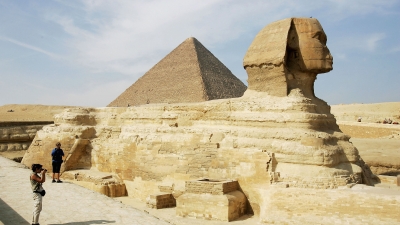
The pyramids of Egypt are amongst the most impressive monuments of the ancient world. The largest are the three pyramids at Giza. The Great Pyramid of Cheops measures 755 ft (230 m) along each side and stands 481 ft (147 m) high. It has been estimated that it must contain 2,300,000 blocks of stone.
As were other pyramids, the Great Pyramid was built as a tomb for one of the god-kings (Pharaohs) of ancient Egypt. The pyramids were built during the Old Kingdom and date back more than 4,500 years.
If the Pyramids helped to build ancient Egypt, they also preserved it. Giza allows us to explore a long-vanished world.
“Many people think of the site as just a cemetery in the modern sense, but it’s a lot more than that,” says Museum of Fine Arts, Boston, and Tufts University Egyptologist Peter Der Manuelian. “In these decorated tombs you have wonderful scenes of every aspect of life in ancient Egypt—so it’s not just about how Egyptians died but how they lived.”
Tomb art includes depictions of ancient farmers working their fields and tending livestock, fishing and fowling, carpentry, costumes, religious rituals, and burial practices.
Inscriptions and texts also allow research into Egyptian grammar and language. “Almost any subject you want to study about Pharaonic civilization is available on the tomb walls at Giza,” Der Manuelian says.
To help make these precious resources accessible to all, Der Manuelian heads the Giza Archives Project, an enormous collection of Giza photographs, plans, drawings, manuscripts, object records, and expedition diaries that enables virtual visits to the plateau.
Older records preserve paintings or inscriptions that have since faded away, capture artifacts that have been lost or destroyed, and unlock tombs not accessible to the public.
Armed with the output of the longest-running excavations ever at Giza, the Harvard-Museum of Fine Arts, Boston Expedition (1902-47), Der Manuelian hopes to add international content and grow the archive into the world’s central online repository for Giza-related material.
But he stresses that nothing could ever replicate, or replace, the experience of a personal visit to Giza.
Picture Credit : Google




